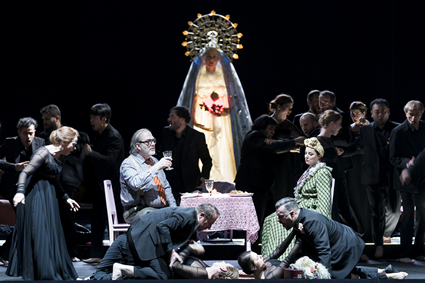| Opera Reviews | 18 April 2024 |
An overcooked production is saved by fine singingby Moore Parker |
|
| Spontini: La vestale
Theater an der Wien 23 November 2019 |
|

Ensemble
|
|
|
Despite the occasional revival here and there, Spontini’s La vestale remains something of a rarity - and one perhaps often associated with the legendary photos of Visconti’s first opera production - at La Scala in 1954, which served as an additional new vehicle for Maria Callas as well as for the debut there of the tenor, Franco Corelli. One element this new Theater an der Wien reading (in French) shares with that grand milestone is the white pleated skirt - a flattering feature enjoyed here by Julia and her Vestal associates. Otherwise, Director Johannes Erath and his Costumer, Jorge Jara appear to have aimed for a kaleidoscope of “100 Best Stage Effects” in an attempt to multilayer the basically straightforward plot, with simultaneous storylines and historic periods meshed with the essentials of the drama - all resulting in an unfortunate overload which ultimately bordered not only on the farcical, but also the incomprehensible in places. The actual staging (Katrin Connan) began optimistically, with a rotating, fully-neutral, illuminated floor-to-ceiling cube which soon rises to reveal the dark realm of the unhappy Vestals. The use of Black and White as symbols is overlaid with projections (Bibi Abel) and a colourful mix of props which include a stuffed eagle (S.P.Q.R. symbol) and a glowing red heart (for Julia to contemplate), a Roman helmet, a miniature Madonna (which is ultimately countered by a giant larger-than-life version within which Julia is initially destined to meet her end), and basins of real water - all in addition to contemporary furnishings for the flip side of the concept. Clearly a product of much intellectual pondering, and one resulting in individual ideas and effects which bore potential and were visually powerful - not least, thanks to Bernd Purkrabek’s clever lighting. The roles were well cast with all the soloists showing a concerted effort to project text as much as tone, and energise their stage characters as much through word as through deed. Statuesque in vocal quality as much as in physique, Elza van den Heever well-suits the classical line of Spontini’s Julia - bringing a combination of pristine tone, technical finesse, and a personable, sympathetic reading which rang true - and which echoed deserved success. An ideal foil, Michael Spyres’ Licinius was surprisingly dark-toned and weighty in quality, and testimony to a now-broadened repertoire which includes Beethoven’s Florestan, Énée in Les Troyens, and Don José in Carmen. He is a model technician, easily finding scope for Licinius’ scale of dramatic expression with ample reserve while solidly contrasting with the rather bizarre figure of Cinna. La Grande Vestale is introduced here as a black trouser-suited Domina (complete with riding crop) before pairing-up with The High Priest (Franz-Josef Selig) as a present-day ageing couple - a union so embroiled that she eventually stabs him to death at the dinner table. At the evening’s positive conclusion he is, however, resurrected by a touch of Julia’s hand. Claudia Mahnke made much of the part, nicely-understating the characters she depicted, and vocally a fine match for the two powerful soprano and tenor leads. Sébastien Guèze’s Cinna is here portrayed as a fanatical gymnast - switching between T-shirted push-ups and prize-winners’ pedestals in hinting at the figure’s lust for prowess and power. In his house debut, the spritely French tenor well-nailed the character with his full-toned, appropriately-callous, timbre and his boundless physical energy. As Le Souverain Pontife Franz-Josef Selig was wonderfully characterful - repulsively seedy, and a touch lecherous with the Vestals, while utilising his palette of cavernous utterances to Strong support too by Dumitru Mădărășan as Le Chef des Aruspices and Ivan Zinoviev as a Consul. The Vienna Symphony Orchestra under Bertrand de Billy appeared oddly alien to the score at times - particularly in segments of through-composed dialogue which tended to plod and flag - but much more winning in other sections, with significant highlights in various choral scenes (Arnold Schoenberg Chor), as well as in some of the soloists’ set pieces.
|
|
| Text ©
Moore Parker Photo © Werner Kmetitsch |
|







